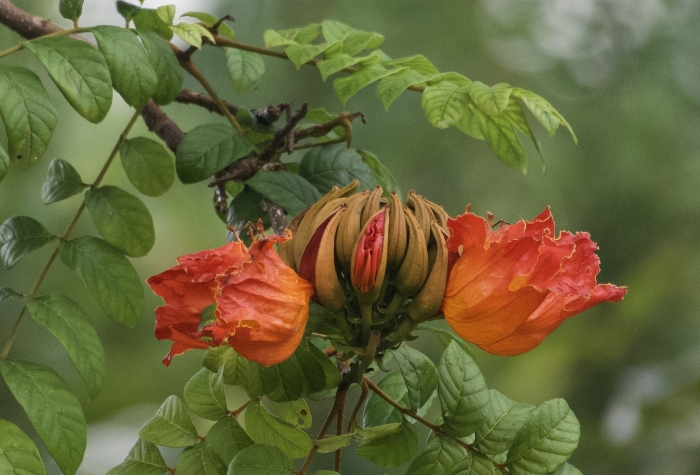African Tulip Tree
(Spathodea campanulata)
African Tulip Tree (Spathodea campanulata)
/
/

Jonathan Eisen
CC BY 4.0
Image By:
Jonathan Eisen
Recorded By:
Copyright:
CC BY 4.0
Copyright Notice:
Photo by: Jonathan Eisen | License Type: CC BY 4.0 | License URL: http://creativecommons.org/licenses/by/4.0/ | Rights Holder: Jonathan Eisen | Publisher: iNaturalist | Date Created: 2019-12-07T16:07:34-08:00 |









































































Estimated Native Range
Summary
Spathodea campanulata, commonly known as the African tulip tree, is a deciduous tree native to the moist and semi-deciduous forests of Sub-saharan Africa. It can grow between 7–25 m (23–82 ft) tall, with a typical width of 6–10 m (20–33 ft). The African tulip tree is renowned for its large, showy, reddish-orange flowers that appear in clusters, primarily in the winter and spring, creating a spectacular display. The flower buds are ampule-shaped and can hold water, which is a source of amusement for children who play with them to squirt water. However, the sap can stain yellow on fingers and clothes. The open, cup-shaped flowers also capture rain and dew, making them a resource for birds.
The African tulip tree is valued for its ornamental qualities, including its vibrant flowers and its ability to provide shade. It is often used in tropical and subtropical landscapes, including urban settings, as a specimen tree. While it prefers full sun, it can tolerate a range of soil types, provided they offer medium drainage. Regular watering is necessary to establish the tree, but once established, it can tolerate moderate drought. Gardeners should be aware that the African tulip tree can be invasive outside its native range, and it is considered a threat to native ecosystems in places like Hawaii, Mexico, and South America. It is recommended to consult local regulations before planting.CC BY-SA 4.0
The African tulip tree is valued for its ornamental qualities, including its vibrant flowers and its ability to provide shade. It is often used in tropical and subtropical landscapes, including urban settings, as a specimen tree. While it prefers full sun, it can tolerate a range of soil types, provided they offer medium drainage. Regular watering is necessary to establish the tree, but once established, it can tolerate moderate drought. Gardeners should be aware that the African tulip tree can be invasive outside its native range, and it is considered a threat to native ecosystems in places like Hawaii, Mexico, and South America. It is recommended to consult local regulations before planting.CC BY-SA 4.0
Plant Description
- Plant Type: Tree
- Height: 25-40 feet
- Width: 15-25 feet
- Growth Rate: Rapid
- Flower Color: Orange, Red
- Flowering Season: Spring, Winter
- Leaf Retention: Evergreen
Growth Requirements
- Sun: Full Sun
- Water: Medium
- Drainage: Medium
Common Uses
Bird Garden, Hummingbird Garden, Showy Flowers
Natural Habitat
native to the moist and semi-deciduous forests of Sub-saharan Africa
Other Names
Common Names: Flame-Of-The-Forest , Flametree , African Tuliptree , Tuliptree , Fireball , Fountain Tree , Afrikanischer Tulpenbaum , Tulipán Africano , Tulipier Du Gabon , Afrikanskt Tulpanträd
Scientific Names: Spathodea campanulata , Spathodea nilotica , Spathodea campanulata subsp. nilotica , Spathodea campanulata subsp. congolana , Spathodea nilotica f. bryanii , Spathodea tulipifera , Bignonia tulipifera , Spathodea danckelmaniana
GBIF Accepted Name: Spathodea campanulata Beauv.